This whole "orbs" business begins in the 90's when "experts in the paranormal" in the United States discovered this phenomenon by taking night photographs in cemeteries in the hope to photograph ghosts.
Previously, "orbs" already appeared on photographs, but almost everyone realized that there is nothing out of the ordinary about that. But in the context of cemeteries at night and "research" on hosts, it suddenly took an importance it rightfully never had before.
Thereafter, an "explosion" of "Orbs" started: many people had some on their photographs, and published them on the Internet in amazement and wondering. The "Orbs" seemed to wander out of cemeteries, and were also photographed in allegedly haunted houses, in nature, in barns, everywhere, and they thus finished by being considered, depending on the context, as ghosts, angels, invisible alien beings, UFOS, spaceships, plasma balls, balls of lights creating crop circles and so on.
That's what "they" call Orb:
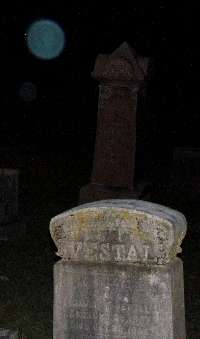
|
Of course, there can be several "Orbs" on a photograph.
And, as often with phenomena that not everyone understands, there are phenomena which are not "orbs" but are attached to the topic: when people want to see mystery where there is no mystery, they like to mix all and everything in the same pot; which makes the matter very confused!
When you take a photograph, you focus the camera lenses, so that the subject of your photograph is clear. This focusing is done automatically most of the time with today's cameras.
In result of focusing, the subject that you photograph will be clear, but something nearer or farther might be very fuzzy, particularly if your photograph is made in the inside, or by night, much less if you photograph is of a remote landscape in the broad daylight; focus on the infinite and enough light in clean air is not a good opportunity to capture "orbs".
When you take your photograph of a not very remote subject, with a lack of lighting, there can be, between the camera and the subject that you photograph, all kinds of things which you do not see with the naked eye because they are small, and because by looking at the small image in the viewer, your field of vision is naturally much more reduced than when you look directly at things.
Among the stuff between the camera and the subject, you can get:
If you have a small piece of dust in front of your camera's objective, whereas focus is on the photographed subject farther away, your tiny dust will be fuzzy, its image will be much larger than the piece of dust really is:
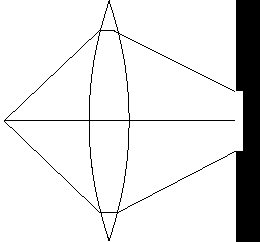
On the above image, the small dust is on the right, close to the objective. Its light passes in the lens, but as the focus is on farther objects, on the CCD sensor or the negative film, behind the lens, on the right on the image, instead of an image the size of the small dust, you will get a much larger blurry image of it!
When you make photographs under weak lighting conditions, you use the flash, which besides generally engages automatically, to light the scene.
The flash will light up your subject, but also all the dust, insects, droplets, etc., between the camera and your subject. It will make them very visible, and they will thus appear on the photograph but as they are out of focus, they will appear large and fuzzy.
Worse still, if they are not very opaque, if they are transparent, like droplets, some dust, small insects with their diaphanous wings, they will be iridescent.
They will be iridescent because they will act like a multitude of small prisms, and will decompose the light of the flash in all the colors of the rainbow.
The light will be disturbed. Because it has wave properties, it will literally curbed while passing between the edges of all the holes in what constitutes the object.
There will be also diffraction, and interferences:
Imagine the sea, with its waves which arrive the ones after the others onto a motionless boat. If you look at around the boat, you will see that eventhough it is motionless, it generates waves around him. Circulars waves that move away from the boat. It is of course not the wind which that creates these ripples, it is diffraction. The same thing occurs when light arrives on a piece dust or a droplet.
These waves can be relatively chaotic, not as simple as those that occur when you throw a stone in a pond! The circular waves which are generated by diffraction are not of constant wavelength, they are sometimes a little closer, sometimes a little less close, and they then interfere between them. With the light, this would cause iridescence, as those you can see on a soap bubble, which is also caused by the interferences of the light waves between themselves.
All these phenomena will combine in differing degrees, and as focus is done on other thing, the whole will be enlarged, the blur combined with iridescence not resembling a piece of dust or a droplet anymore.
The "orb" effect on photographs can occur anywhere, provided that the conditions are met.
When somebody "captures an orb" in a cemetery, he would believe that it is a ghost. When it is in a field with a "crop circle", he would believe that the Orbs are mysterious "things" that create crop circles. When it is in some place where there is a buzz of paranormal phenomena, he would think he captured the proof of the paranormal phenomena. When it is in the attic of the old family mansion, there you go, that's Grandpa's soul wandering about...
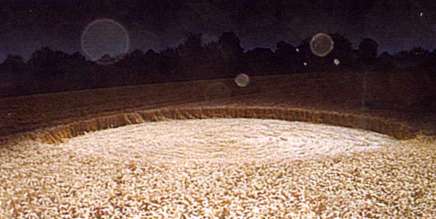
|
When stuff are out of focus, they take a roundish aspect, even if they are not actually round at all.
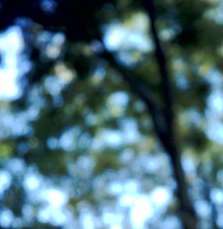
|
What you see above is the sky behind the foliage of a tree. The foliage is out of focus. The "holes" between the leaves take a round aspect, whereas they are obviously not round in reality!
The more out of focus, the rounder it looks.
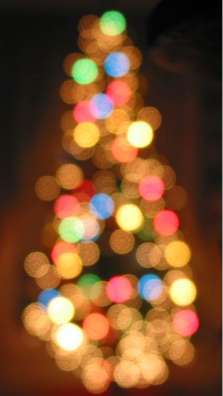
|
What you see above here is quite simply a Christmas tree and its colored lights, in a voluntarily out of focus photograph. All the small lights look larger and very circular.
A spec of dust, a hair, do not have all the colors of the rainbow, normally. But everyone knows, or should know, what happens with light when it crosses anything a bit transparent which would not be made up of flat parallel sides like a window is.

|
When white light, or a light which seems made "of only one color", passes through a body which has transparency and whose sides are not very parallel, like this prism, the components of this light are broken. This is known since the time of Isaac Newton who much thought about it, and can be seen in nature when a rainbow occurs, in which the all the water drops together act like a giant prism, or a giant lens afflicted with chromatic aberration.

|
A hair under the microscope. Hair, dust, moths wings powder, wings of small insects, snowflakes, droplets of fog or vapor, are more or less transparent, and when struck by light, they can break up this light in its basic colors like a prism does. These small objects actually seldom have parallel sides like a window, and very easily make the effect of prisms that breaks up the light into its basic color components.
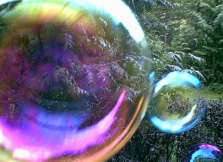
|
Soap bubbles: here, the coloring is not exactly an effect of prism, but the interference of the light with itself. The details of these interferences, on the soap bubbles, which are quite smooth and large, is well too small to be seen with the naked eye, it is only the total effect of rich "coloring" that appears to the eye.
When you throw a stone in a pond of water, you get a wave pattern on the surface of the water which is a series of concentric circles formed by the waves which move away from the place where your stone hit the water surface. If you throw two stones at the same time, not too far one from the other, you will see the waves from one stone and from the other stone start to cross and make a interesting complex figure: according to places, the waves will add their effects, or will subtract their effects, or will cancel one another. If you launched two stones close enough one from the other, you can get very spectacular aspects: you see an interference pattern between the two series of circulars ripples.
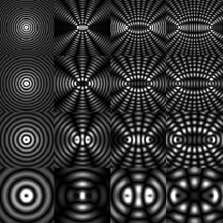
|
The light is not a wave like the waves on water, but it has certain waves characteristics. Like the waves on the water when you throw stones, light can interfere with light, and you would get all sorts of resulting interference patterns, as shown here. Sometimes these are called "a moiré effect."
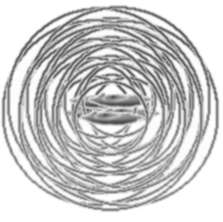 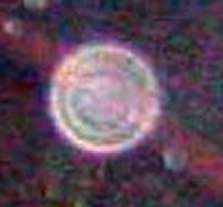
|
You can imagine that a dust spec or a small insect is a little like a boat on the water, which makes waves around him, with the blur which makes the waves superimpose, and interfere in all directions. That gives you something overall round but with a chaotic texture, like you can see here, with all kinds of variations, obviously, on those "Orbs" photographs.
Of course, most of the times you do not get such pretty effects. In these cases, people who took the photograph simply understand that there is no mystery, that it is only small out of focus stuff, and they do not make a big fuss of it.
You can visually observe the same sort of optical phenomena with the naked eye if you are short-sighted: Put off your glasses, and go look at distant lights at night outside.
Another possibility still, is what happens with over-intensive use of the powerful zoom of nowadays digital video cameras when a remote source of light is shot. The following image is quite simply Venus shot in video with heavy zooming, and mistaken for an alien spaceship by the cameraman:
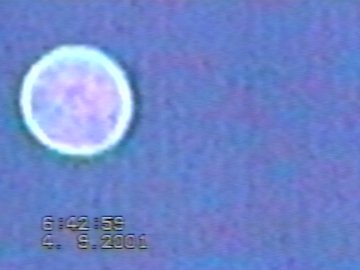
Although it is a while that the orbs effect is understood and explained by the serious ufologists, there are mystery worshippers or UFO buffs who are not well-informed or who do not want to hear reason anyway. There are also people who, having found "orbs" on their photographs, are amazed by that, and either seek explanations or forget to seek explanations when they stumble on the silly websites that promotes "orbs" as ghosts or alien stuff. That's hardly surprising: not everyone can be well informed, and beyond the small core of the informed and serious ufologists, there is all the same a huge crowd of people who cannot know - or do not really want to know. When ufologists explain to them what are these "orbs" are nothing out of this world, the majority of sensible people understand. But there will always remain some wacky people who do not want to understand. Here are remarks that some of them threw at me to continue to claim that the explanation of the orbs given here is "not true" and that "Orbs" are "mysterious" anyway.
"There are orbs also on paper photographs, not just on digital photographs."
Nobody had said that that orbs only occur on digital photographs! It can also occur with classic photographs using negative film. "Orbs" are not related to whether the camera is digital or not.
"On one of my picture you can see an orb coming out of the ground."
As incredible as it seems, an amateur UFO buff wrote that to me. But on a photograph, you do not see motion. To say that the orb "comes out of the ground" is utterly silly. What happens sometimes is that the orb can get partly very dimmed by a very dark or lighted background. It does not mean that you see it "coming out" of anywhere!
"We went to Col de Vence, and captured lots of Orbs there."
Col de Vence, in France, is a place that became famous just because there were some more or less interesting UFO sighting reports from there. Now it has become a gathering place for all sorts or UFO buffs and enthusiasts of the paranormal, who are shooting photographs by hundreds and of course, sometimes get "paranormal phenomena" on their images. There is of course nothing relevant when an Orb is captured at this or that place, the "Orb" effect occurs everywhere, it is not "reserved" to certain places. All that is needed is that light and distance conditions are ok.
"At Col de Vence, we captured any orbs while there was no moisture in the air."
This chap wrongly thought that orbs are only occurring when there are water drops or droplets. But the Orbs are cause by any small things in the air near the camera: insects, spiders, fragments of cobweb, dandruff, dust, hair, pollen, coughs droplets, vegetal debris falling from trees, snowflakes etc...
"There were several cameras, and it is only on some camera's photographs that the Orbs appeared."
That should naturally make any sensible people realize that these orbs are only a particular photographic effect related to particular conditions, but certain amateurs think that it proves that the Orbs are "paranormal" or "unexplained". It is however obvious that if for example a small dust spec is 10 centimeters in front of the objective of one of the camera, it won't be just as close in front of the other cameras!
"I have captured an Orb in daylight without using the flash."
The flash is not the only source of light which can make "Orbs" visible. Any source of light, such as for example the good old sun, can be diffracted and produce the "Orb" effect. Simply, in the night, with the flash, this effect is more noticeable and spectacular because there is often a dark background. It should also not be forgotten that the flash might have functioned even by day and without the photographer noticing or remembering.
"As it seems that the flash makes the orbs appear, I used projectors instead and I captured Orbs all the same."
The projectors are then quite simply the source of light having resulted in the Orb effect exactly as the flash would have.
"I had carefully cleaned the objective, there was no dust on it."
That does not prevent at all the presence of dust or other stuff in the air in front of the objective!
"There were already testimonies of Orbs in the ancient texts of the Roman empire."
Some particularly unreasoned amateurs would mix all and anything together, won't they? They would not even realize that the ancient Romans, who did not take photographs, could have seen meteors or UFOs but that it has nothing to do with the "Orbs" discussed here, which are defined photographic phenomenon. Orbs on photographs have obviously nothing to do with balls of fire passing in the sky described by Latin authors, the explanation of the "Orbs" of the photographs is obviously not the universal solution of all the mysteries of the Heavens and Earth!
For example, the images below, whatever they are, are obviously not what anyone should call "Orbs", all the UFO sighting reports and all the alleged UFO photographs are obviously not this "Orb phenomenon"!
 |
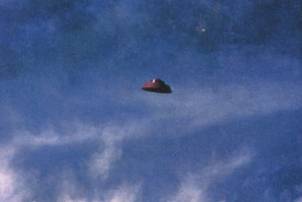 |
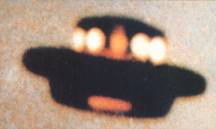 |
"I photographed raindrops and they did not appear as orbs, you can clearly see that they are just raindrops."
Not all things photographed result in "Orbs". The "Orb effect" occurs only when a whole number of conditions are cumulated, that relate to the amplitude of in the camera focusing, depending a lot on the distance, lighting, speed or immobility of objects etc. These conditions are not very, very rare, but they obviously are not occurring that often either.